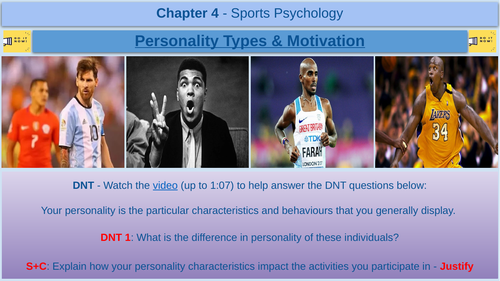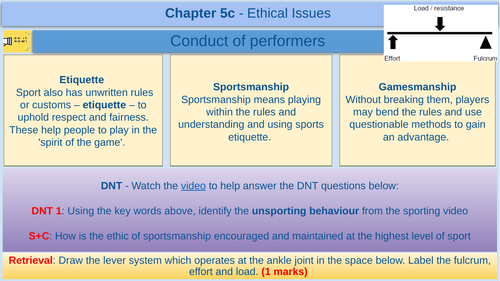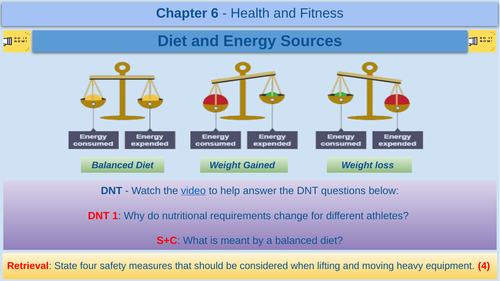
221Uploads
34k+Views
7k+Downloads
Physical education

Personality Types & Motivation - GCSE Physical Education - AQA
Resource includes PowerPoint presention and differentiated worksheets for a 1 hour lesson, following the AQA specification.
Chapter 4 - Sports Psychology
Lesson 1 - Classification of Skills
Lesson 2: SMART Targets
Lesson 3: Information Processing Model
Lesson 4: Types of Guidance
Lesson 5: Types of Feedback
Lesson 6: Inverted-U Theory - Arousal and Stress Management
Lesson 7: Aggression
Lesson 8: Personality Types & Motivation

Conduct of performers - GCSE Physical Education - AQA
Resource includes PowerPoint presention and differentiated worksheets for a 1 hour lesson, following the AQA specification.
Chapter 5c - Ethical Issues
Lesson 1 - Players’ conduct
Lesson 2 - Prohibited Substances
Lesson 3 - Spectator Behaviour

Diet and Energy Sources - GCSE Physical Education - AQA
Resource includes PowerPoint presention and differentiated worksheets for a 1 hour lesson, following the AQA specification.
Chapter 6 - Health and Fitness
Lesson 1: Health, well-being and fitness
Lesson 2: Sedentary Lifestyle
Lesson 3: Somatotypes
Lesson 4: Diet and Energy Sources

Pre-industrial Britain (Pre 1780)
Chapter 3.1 - Emergence of the globalisation of sport in the twenty-first century
Resource includes PowerPoint presention and differentiated worksheets for a 1 hour lesson, following the AQA specification.
Students will be able to:
AO1: To know the characteristics of pre-industrial Britain (Pre 1970)
AO2: To apply these characteristics to popular recreation
AO3: To evaluate how social-cultural factors affected sport pre industrial revolution
Feedback is welcome, please check out the rest of my lessons.

Popular recreation sports
Chapter 3.1 - Emergence of the globalisation of sport in the twenty-first century
Resource includes PowerPoint presention and differentiated worksheets for a 1 hour lesson, following the AQA specification.
Students will be able to:
AO1: To know the characteristics of pre-industrial Britain (Pre 1780)
AO2: To apply these characteristics to popular recreation
AO3: To evaluate how social-cultural factors affected sport pre industrial revolution
Feedback is welcome, please check out the rest of my lessons.

The Industrial and Post-Industrial Revolution effects on Society (1780 - 1900)
Chapter 3.1 - Emergence of the globalisation of sport in the twenty-first century
Resource includes PowerPoint presention and differentiated worksheets for a 1 hour lesson, following the AQA specification.
Students will be able to:
AO1: To know the characteristics of industrial Britain (1780 - 1840)
AO2: To these characteristics to rational recreation
AO3: To begin to evaluate how social-cultural factors affected sport during the industrial revolution
Feedback is welcome, please check out the rest of my lessons.

Post-1950: The changing status of performers
Chapter 3.1 - Emergence of the globalisation of sport in the twenty-first century
Resource includes PowerPoint presention and differentiated worksheets for a 1 hour lesson, following the AQA specification.
Students will be able to:
AO1: To know the historical barriers that influence female participation in sport
AO2: To apply these barrier to football, tennis and athletics
AO3: To evaluate whether these historical barriers are still present today
Feedback is welcome, please check out the rest of my lessons.

Under-represented groups in sport
Chapter 3.2 - The impact of sport on society and of society on sport
Resource includes PowerPoint presention and differentiated worksheets for a 1 hour lesson, following the AQA specification.
Students will be able to:
AO1: To identify certain under-represented groups in sport
AO2: To identify barriers to participation and possible solutions
AO3: To evaluate the effectiveness of these solutions
Feedback is welcome, please check out the rest of my lessons.

Sport on Society - Key Terms
Chapter 3.2 - The impact of sport on society and of society on sport
Resource includes PowerPoint presention and differentiated worksheets for a 1 hour lesson, following the AQA specification.
Students will be able to:
AO1: To define key sociological terms in relation to the study of sport
AO2: To apply their impact on equal opportunities in sport and society
AO3: To analyse sporting participation in relation to socialisation
Feedback is welcome, please check out the rest of my lessons.

Sport England's and local/national partners
Chapter 3.1 - Emergence of the globalisation of sport in the twenty-first century
Resource includes PowerPoint presention and differentiated worksheets for a 1 hour lesson, following the AQA specification.
Students will be able to:
AO1: To identify the interrelationship between Sport England, local and national partners
AO2: To apply this knowledge to the unrepresented groups in sports
AO3: To evaluate the effectiveness of these Sport England campaigns
Feedback is welcome, please check out the rest of my lessons.

Social Action Theory
Chapter 3.2 - The impact of sport on society and of society on sport
Resource includes PowerPoint presention and differentiated worksheets for a 1 hour lesson, following the AQA specification.
Students will be able to:
AO1: To know and understand social action theory
AO1: To know how this theory is supported by the interactionist approach
AO2: To apply these theories towards equal opportunities in sport and society
Feedback is welcome, please check out the rest of my lessons.

Sports Analytics
Chapter 4.1 - Diet and nutrition and their effect on physical activity and performance
Resource includes PowerPoint presention and differentiated worksheets for a 1 hour lesson, following the AQA specification.
Students will be able to:
AO1: To identify the use of technology in data collection, including an understanding of key terms
AO2: To explain how sports analytics may be beneficial for a performer
AO3: To discuss the role of technology for a coach in the analysis of performance
Feedback is welcome, please check out the rest of my lessons.

Exercise-related function of food classes
Chapter 4.1 - Diet and nutrition and their effect on physical activity and performance
Resource includes PowerPoint presention and differentiated worksheets for a 1 hour lesson, following the AQA specification.
Students will be able to:
AO1: To identify the structure and function of each food class
AO1: To identify the sources of each food class
AO3: To evaluate the differing effects of foods on sports performance
Feedback is welcome, please check out the rest of my lessons.

Video Analysis
Chapter 7.2 - The role of technology in physical activity and sport
Resource includes PowerPoint presention and differentiated worksheets for a 1 hour lesson, following the AQA specification.
Students will be able to:
AO1: To identify the use of video and analysis programmes in sport
AO2: To explain how both quantitative and qualitative data to analyse the effectiveness of performance
AO3: To discuss the effectiveness of technology for athletes wanting to improve their performance
Feedback is welcome, please check out the rest of my lessons.

Testing and Tracking Equipment
Chapter 7.2 - The role of technology in physical activity and sport
Resource includes PowerPoint presention and differentiated worksheets for a 1 hour lesson, following the AQA specification.
Students will be able to:
AO1: To identify testing and recording equipment in sport
AO2: To explain how GPS and motion tracking technologies are being used in sport
AO3: To evaluate data integrity when using technology in sport analytics
Feedback is welcome, please check out the rest of my lessons.

Information Processing Model
Chapter 9.1 - Information Processing
Chapter 7.2 - The role of technology in physical activity and sport
Resource includes PowerPoint presention and differentiated worksheets for a 1 hour lesson, following the AQA specification.
Students will be able to:
AO1: To describe the basic components of information processing model
AO2: To apply this knowledge to sporting situations
AO3: To evaluate this model against the stages of learning
Feedback is welcome, please check out the rest of my lessons.

Attribution Theory
Chapter 12.1 - Psychological factors that can influence an individual in physical activities
Resource includes PowerPoint presention and differentiated worksheets for a 1 hour lesson, following the AQA specification.
Students will be able to:
AO1: To identify the concepts of attribution theory, self-serving bias and learned helplessness
AO2: To apply these concepts to sporting situations
AO3: To suggest strategies to prevent learned helplessness from occurring
Feedback is welcome, please check out the rest of my lessons.

Achievement Motivation
Chapter 12.1 - Psychological factors that can influence an individual in physical activities
Resource includes PowerPoint presention and differentiated worksheets for a 1 hour lesson, following the AQA specification.
Students will be able to:
AO1: To describe the varying types of motivation and the key characteristics of need to achieve and need to avoid failure personality types
AO2: To apply to sporting situations
AO3: To suggest strategies to develop approach behaviour and apply examples of achievement goal theory.
Feedback is welcome, please check out the rest of my lessons.

Schema Theory
Chapter 9.1 - Information Processing
Resource includes PowerPoint presention and differentiated worksheets for a 1 hour lesson, following the AQA specification.
Students will be able to:
AO1: To describe Schmidt’s schema theory
AO2: To apply the schema theory in sporting situations
AO3: To analyse the strategies to improve information processing
Feedback is welcome, please check out the rest of my lessons.

Structure of the skeletal system - GCSE Physical Education - AQA
Resource includes PowerPoint presention and differentiated worksheets for a 1 hour lesson, following the AQA specification.
Chapter 1a - Applied anatomy and physiology
Lesson 1: Bones of the skeleton
Lesson 2: Structure of the skeletal system
Lesson 3: Functions of the Skeletal System
Lesson 4: Structure of a synovial joint - Part 1
Lesson 5: Structure of a synovial joint - Part 2
Lesson 6: Muscles
Lesson 7: Antagonistic pairs




















